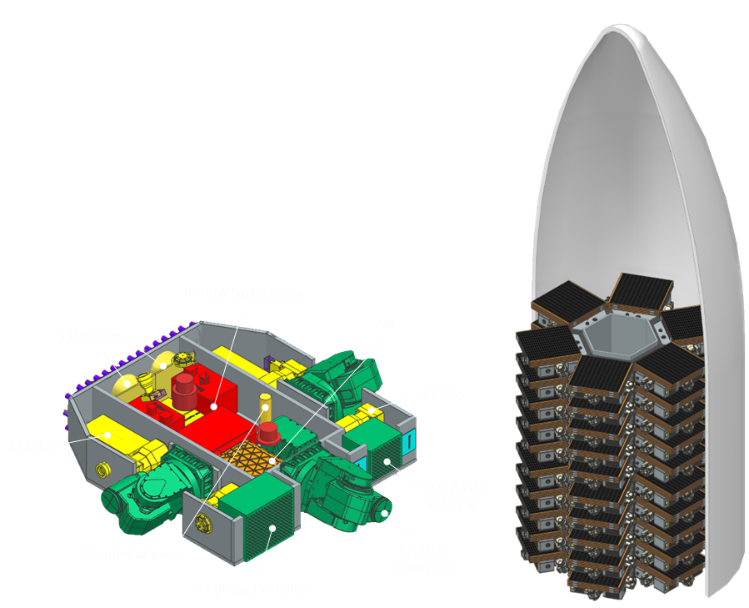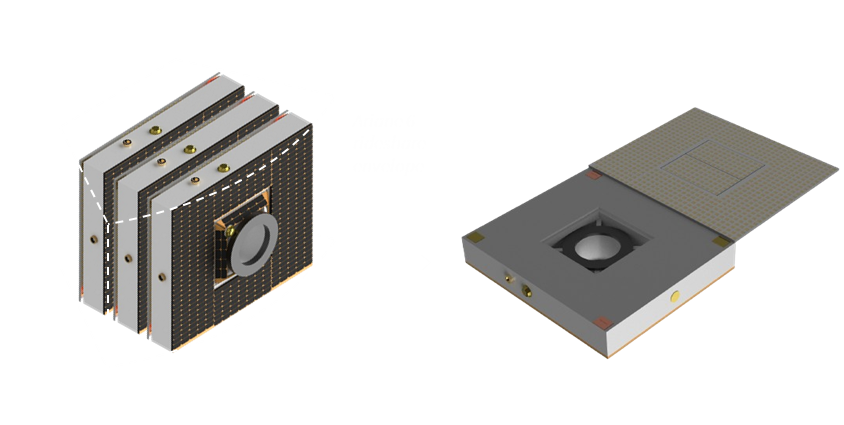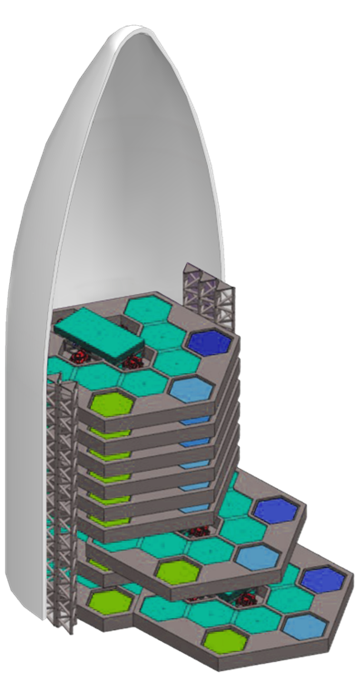-
StatusCompleted
-
Status date2024-08-16
-
Activity Code1B.137
The space sector is undergoing unprecedented transformation and development on a global scale. Major technology advancements, a new entrepreneurial spirit and a renewed policy focus have put the space sector under the spotlight on the global innovation stage. Satellite constellations in LEO are at the core of this transformation. Especially for SatCom constellations, new satellite form factors such as high-aspect ratio (HAR) satellites show potential as they are already used by some industry players today.
This objective of the study was to provide an overview of the status quo of HAR satellites and understand the reasons behind the rising interest, along with possible advantages and disadvantages they might entail. Furthermore, the project aimed to determine how these innovative satellite configurations could add value to Satellite Communications, and if so, what ESA could do to lower the barrier of entry for industry and foster the adoption of this novel satellite form factor.
A key challenge for industry wanting to develop a HAR satellite, stems from the absence of established precedents for HAR configurations, leaving new entrants with limited literature and knowledge resources. Especially for smaller players that don’t have the funds to develop a new satellite platform from scratch, the absence of a widely adapted HAR-specific standard presents a challenge.
Given the novelty of the concept, the availability of COTS components and systems can be an issue depending on the specific concept. HAR satellites demand specialised elements like batteries and fuel tanks designed specifically for their elongated form. This bespoke requirement may elevate development and manufacturing costs, or hinder optimal utilisation of benefits by using components intended for conventional satellites, which may not be well-suited for the HAR design.
Thermal management and radiation resistance are also concerns, as larger surfaces may experience uneven heat distribution. Innovative solutions may offer alternatives, however.
Another challenge is light pollution, given that flatter and longer configurations tend to reflect more sunlight than traditional cubic satellites with similar performance.
While these challenges are not insurmountable, addressing them is crucial maximising the potential that HAR satellites offer.
High aspect ratio (HAR) satellites represent a promising satellite innovation with distinct advantages over traditional counterparts.
The key reason why some companies are shifting towards HAR satellites is the ability to more efficiently stack satellites in launch vehicles. This stackability facilitates the swift and efficient deployment of large constellations, reducing launch costs and complexity.
Another advantage that is also especially important for mega-constellations is the fact that the satellite components can
easily be spread throughout the satellite body without the need to stack them using cumbersome harnesses and interconnections. This characteristic can facilitate more efficient automated series production of satellites.
Their elongated shape provides an increased surface area to volume ratio, enabling greater power generation and larger payloads compared to traditional satellites of similar mass. The lower drag coefficient of HAR satellites can also extend the satellite’s orbital lifespan and enables prolonged missions in Very Low Earth Orbit (VLEO).
Overall, HAR configurations have the potential to significantly influence the European space industry. Their cost-effectiveness, stackability, and streamlined manufacturing processes position HAR satellites as optimal choices for large constellations, offering a faster deployment rate compared to other alternatives.
As part of the project, three high-level HAR concepts have been developed by Reflex Aerospace. The three selected use cases for this exercise were secure broadband, Synthetic Aperture Radar (SAR) satellites, as well as a modular bus.
The first secure broadband concept is composed of 140 satellites that were designed to enhance stackability and mass production, reducing launch costs and expediting the launch programme. 60 satellites could be launched at once with Ariane 6, using a dedicated deployer system. The HAR surface area can be used for heat dissipation, and to deployable fit solar arrays, optical Inter-Satellite Links (ISL) and phased array antennas.

HAR constellations can also play a significant role in selected applications in the Earth observation domain, such as SAR. The conceptualised SAR configuration also leverages the stackability and large surface area of HAR to obtain a design that allows for several powerful satellites to be launched at once, to build a large constellation allowing for short revisit times. The developed concept allows for three satellites to be stacked within a single rideshare slot, reducing launch costs and maximising operational responsiveness. The concept also uses COTS components to ensure cost-effectiveness while adhering to HAR design ratio goals. Its capacity to fully leverage the available large flat surface is facilitated by the use of deployable SAR antennas.

HAR satellites could be used for many other use cases, including military, scientific, and many other applications, which would greatly benefit from the numerous advantages that characterise HAR designs. A flexible option for leveraging the advantages of HAR for different applications is a multi-purpose bus. Reflex Aerospace developed a HAR modular bus concept, which could be used for various missions depending on the needs of the clients. The bus consists of a modular hexagonal transfer vehicle architecture with 13 hexagonal slots. Each slot can be configured in different ways, meaning the transfer vehicle can host multiple satellite types simultaneously. The transfer vehicles are stacked and integrated into specific fairing structure in the way that each can slide out from the fairing with subsequent separation from the launch vehicle. Once separated from the launch vehicle they can attain the satellites’ target orbit via their own propulsion system.

The study started from a holistic view of the industry and proceeds by adding layers of complexity to the analysis. A state of the art market analysis and a potential use case analysis were used as input to for the selection of three use cases for which high-level configurations were developed.
The development of the three HAR configurations started with the definition of general and use-case-specific requirements. Next, a pool of different concepts has been proposed and down-selected. For the winning three concepts, a satellite architecture has been developed and SWOT analyses were built to determine the intricacies of the configurations.
Finally, a business case for one of the configurations/use cases was developed. Based on the findings from all previous activities, a development roadmap and recommendations for ESA were developed to help ESA foster the uptake of HAR satellites in the European space industry.
The project ended in November 2023.




